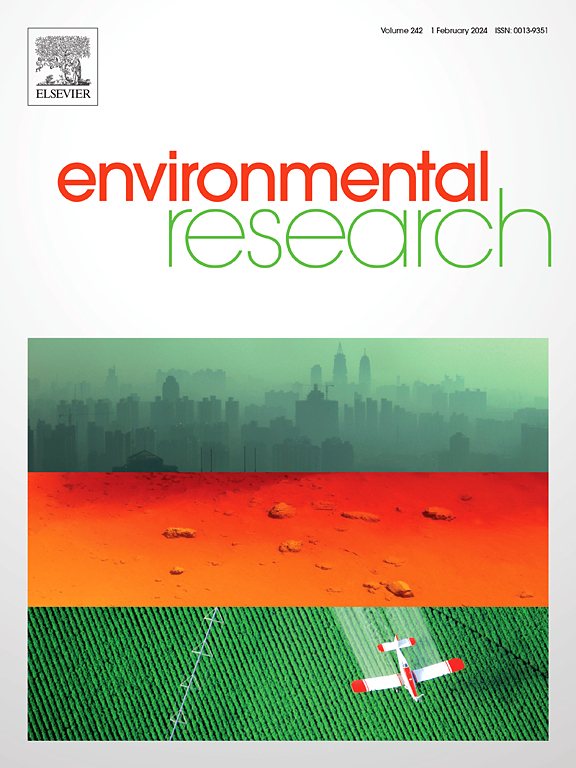斜四角蚓PF3培养脱氮系统去除NO的途径及机制。
IF 7.7
2区 环境科学与生态学
Q1 ENVIRONMENTAL SCIENCES
引用次数: 0
摘要
微藻脱硝技术是一种新兴的烟气脱硝技术,适用于中低浓度NOx的深度处理。针对微藻脱氧技术发展过程中存在的脱氮途径和机制的模糊性,对微藻培养系统中NO的脱氮途径和机制进行了研究。通过研究藻类细胞促进的气液和液固氮传递途径,发现藻类细胞在T. obliquus PF3培养体系去除NO中起关键作用。微藻细胞通过胞外物质分泌、外源铁还原、NO吸附和NO分子吸收等途径增强NO在气液相中的转移。在此过程中,NO在液相中转化为分子NO、离子硝酸盐、亚硝酸盐以及有机络合NO。T. obliquus PF3的可溶性胞外物质主要由腐植酸类和黄腐酸类组成,结合的胞外物质以色氨酸和色氨酸样蛋白为主,两者都具有还原性质,有利于铁还原和NO吸附/络合。通过ATP水解抑制剂HgCl2和系统氮平衡分析,揭示了藻培养液中NO的主要去除途径是NO的溶解和氧化,离子氮是藻类细胞从溶液中吸收和利用的主要形式。本研究阐明了微藻培养系统中NO的去除途径和机理,为微藻脱硝技术的推进和工艺设计提供理论基础。本文章由计算机程序翻译,如有差异,请以英文原文为准。
Removal pathways and mechanism of NO by Tetradesmus obliquus PF3 culture-based DeNOx system
Microalgae-based DeNOx technology, as an emerging approach for flue gas denitrification, is suitable for the deep treatment of NOx at medium to low concentrations. To address the ambiguity surrounding the removal pathways and mechanisms in the development of microalgae DeNOx technology, the pathways and mechanisms of NO removal within a microalgae cultivation system was investigated. By investigating the gas-liquid and liquid-solid nitrogen transfer pathways facilitated by algal cells, algal cells were found to play a pivotal role in NO removal by the T. obliquus PF3 cultivation system. Microalgae cells enhance NO transfer across gas-liquid phases via extracellular substance secretion, exogenous iron reduction, NO adsorption, and NO molecular absorption. During this process, NO is transformed in the liquid phase into molecular NO, ionic nitrate, and nitrite, as well as organically complexed NO. The soluble extracellular substances of T. obliquus PF3 are primarily composed of humic-like acids and fulvic-like acids, while bound extracellular substances are dominated by tryptophan and tryptophan-like proteins, both of which possess reductive properties conducive to iron reduction and NO adsorption/complexation. By employing ATP hydrolysis inhibitor HgCl2 and analyzing nitrogen balance in the system, It was revealed that the primary NO removal pathway involves NO dissolution and oxidation within the algal culture broth, with ionic nitrogen being the predominant form assimilated and utilized by algal cells from the solution. This study clarifies the NO removal pathways and mechanisms within the microalgae cultivation system, thereby providing a theoretical foundation for the advancement and process design of microalgae-based DeNOx technology.
求助全文
通过发布文献求助,成功后即可免费获取论文全文。
去求助
来源期刊

Environmental Research
环境科学-公共卫生、环境卫生与职业卫生
CiteScore
12.60
自引率
8.40%
发文量
2480
审稿时长
4.7 months
期刊介绍:
The Environmental Research journal presents a broad range of interdisciplinary research, focused on addressing worldwide environmental concerns and featuring innovative findings. Our publication strives to explore relevant anthropogenic issues across various environmental sectors, showcasing practical applications in real-life settings.
 求助内容:
求助内容: 应助结果提醒方式:
应助结果提醒方式:


